Background
Herpes simplex virus (HSV) is a double-stranded, enveloped, DNA virus. Herpes simplex virus type 1 (HSV-1) and herpes simplex virus type 2 (HSV-2) belong to the family Herpesviridae, subfamily Alphaherpesvirinae. The herpes viruses are characterized by their propensity for latency in sensory neural ganglia. The site of latency is the trigeminal ganglion in HSV-1 infection1 and the sacral ganglion in HSV-2 infection. Herpes simplex virus infections are ubiquitous and cause a wide range of infections from isolated mucocutaneous lesions to disseminated infection in all age groups. Neonatal herpes simplex virus disease is associated with high morbidity and mortality.2 Herpes simplex virus infections are among the few non-HIV viral infections amenable to antiviral therapy. Available antiviral chemotherapy can be used to treat infection, shorten the clinical course, and, in certain circumstances, prevent infection with herpes simplex virus.
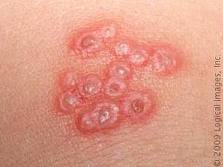
Pathophysiology
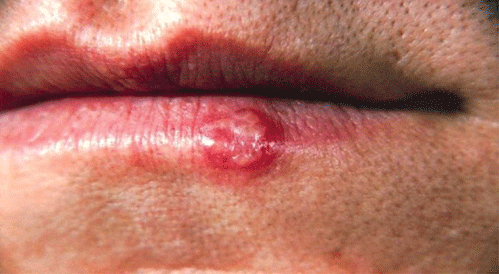
Infection occurs in a susceptible host after virus penetrates abraded skin or mucosal surfaces. After minimal replication at the site of inoculation, the virus travels along the innervating axons to reach the sensory ganglion, where viral replication takes place. Visible lesions result when the virus subsequently returns to the inoculation site via the peripheral sensory nerve, replicates, and causes cell lysis. Lifelong latency and periodic recurrences is a hallmark of herpes simplex virus infection. Some of the stimuli that can precipitate reactivations include exposure to ultraviolet light, stress, hormonal changes, immunosuppression, and intercurrent infection. Histology of skin lesions shows balloon degeneration of infected cells, condensation of nuclear chromatin, and formation of multinucleated giant cells.
Disseminated infection occurs when the host is unable to control viral replication leading to viremia and multiorgan involvement. It is usually seen in neonates and immunocompromised individuals (and very rarely in immunocompetent hosts). Specific immunologic factors responsible for immunity to herpes simplex virus are not completely understood. Both antibody and cell-mediated immunity influence the severity and frequency of recurrences. Herpes simplex virus is also believed to suppress innate immunity by suppressing the production of interferon-alfa and interferon-beta. Additionally, titers of antibodies that mediate antibody-dependent cellular cytotoxicity inversely correlate with severity of neonatal infection.
Frequency: United States
Herpes simplex virus infections occur throughout the world, with humans serving as the only reservoir. The infection is acquired by intimate mucocutaneous contact between a susceptible host and a symptomatic or asymptomatic host shedding virus during primary infection or reactivation. Because the infection results in lifelong latency, the prevalence in any population is cumulative.
Beyond the neonatal period, most primary HSV-1 infections occur in infancy and childhood and are transmitted primarily by contact with infected saliva. Primary HSV-2 infections are acquired after onset of sexual activity and genital herpes infections are among the most common sexually transmitted infections (STIs).
The prevalence of herpes simplex virus infections is influenced by various factors such as socioeconomic status, age, race, and geographic location. One third of children from lower socioeconomic populations have serologic evidence of herpes simplex virus disease by age 5 years compared with 20% of middle-class individuals. Greater person-to-person contact in crowded living conditions is believed to account for the differences in prevalence.
In the United States, HSV-2 seroprevalence increases from about 20-30% in patients aged 15-29 years to 35-60% in patients aged 60 years. This change represents a 30% increase compared with data from 1976-1980. Factors that increase the frequency of HSV-2 infection in older adolescents and adults include gender (more women than men), race (more blacks than whites), marital status (more divorced individuals than single or married individuals), and place of residence (more city residents than suburban residents).
The seroprevalence rate of HSV-2 in pregnant women ranges from 15-30%. Approximately 10% of pregnant women who are HSV-2 seronegative have a sexual partner who is HSV-2 seropositive and are, therefore, at risk of contracting a primary HSV-2 infection during pregnancy. Transmission typically results from contact with an asymptomatic sexual partner with a reported risk of acquisition of approximately 10%. Overall, approximately 2% of women acquire herpes simplex virus during pregnancy.
Frequency: International
Herpes simplex virus has worldwide distribution. The prevalence of genital herpes in developing countries is 2-74% and varies among countries. In African countries that are experiencing HIV epidemics, HSV-2 infection is highly prevalent (>70%). Evidence suggests that genital herpes simplex virus infection increases the risk of HIV infection and that persons infected with both viruses are more likely to transmit HIV.
Mortality/Morbidity
Most cases of infection with either HSV-1 or HSV-2 do not result in serious morbidity. Morbidity and mortality associated with herpes simplex virus are discussed in Complications. Mortality associated with herpes simplex virus is primarily related to perinatal infection, encephalitis, and infection in individuals who are immunocompromised.
At the time of vaginal delivery, the risk of herpes simplex virus transmission from a mother with true primary herpes simplex virus infection to her infant is approximately 50%. Women with primary infections at delivery are 10-30 times more likely than women with a recurrent infection to transmit the virus to their babies. Infants born to mothers with newly acquired infections who do not have primary infections in the presence of preexisting immunity caused by another viral infection (ie, first-episode nonprimary) have a transmission risk of 25-30%.
The neonatal herpes simplex virus infection rate is considered to be less than 2% when the mother has active infection caused by the shedding of herpes simplex virus acquired before pregnancy or during gestation before the onset of labor (recurrent infection). Approximately two thirds of women who acquire genital herpes during pregnancy have no symptoms. Of mothers who deliver an infant with herpes simplex virus infection, 60-80% have no evidence of genital herpes simplex virus infection at the time of delivery and have no history of previous genital infection and have sexual partners with no history. Of babies born to mothers with a primary infection near the time of delivery, 30-50% acquire the infection.
Currently, neonatal herpes simplex virus disease is estimated to occur in approximately 1 per 3000 deliveries in the United States. A recent study determined that herpes simplex virus infection in neonates and infants was associated with substantial morbidity, mortality, and resource use.
Race
Although the risk of herpes simplex virus infection is not related to race, infection rates in the United States vary with race because of various factors, such as racial and ethnic differences in the prevalence of poverty and low socioeconomic status, access to health care, sexual and health-related behavior, and illicit drug use.
By age 5 years, more than 35% of black children are infected with HSV-1 compared with 18% of white children. Through adolescence, the prevalence of antibodies to HSV-1 in blacks is approximately twice the rate among whites. By age 40 years, HSV-1 seroprevalence is similar among blacks and whites. The prevalence of HSV-2 antibodies among blacks is 3-4 times higher than that among whites.
Seroprevalence among women of childbearing age in the late 1970s was estimated to be 50% for blacks and 20% for whites. By the late 1980s, rates of infection had increased to approximately 60% for blacks and 35% for whites. As shown in 2 nationwide surveys of HSV-2 seroprevalence in the last 2 decades, the cumulative lifetime incidence of HSV-2 reaches 25% in white women, 20% in white men, 80% in black women, and 60% in black men.23 Studies have indicated that the seroprevalence of HSV-2 among Hispanics ranges from 17-22.3%. Infants born to non-Hispanic white women may be at higher risk of herpes simplex virus infections. This is a result of a greater likelihood that these women are herpes simplex virus seronegative and at risk of acquiring a primary HSV-1 or HSV-2 infection in late pregnancy.
Sex
Infection rates with HSV-1 tend to be similar in both genders during early childhood. However, through adolescence, the prevalence of antibodies to HSV-1 is slightly higher among females than among males. Rates of HSV-2 infection are higher in women than in men.24 Nationwide surveys of HSV-2 seroprevalence over the last 2 decades have demonstrated cumulative lifetime incidences of 25% in white women and 80% in black women. This compares with rates of 20% in white men and 60% in black men.
Age
Beyond the neonatal period, most childhood herpes simplex virus infections are caused by HSV-1. The seroprevalence of HSV-1 antibodies increases with age, and its rate is 20% by age 5 years. No increase occurs until 20-40 years of age, when 40-60% of individuals are HSV-1 seropositive. As a reflection of the association between infection and sexual activity, many HSV-2 infections occur around puberty and early adolescence. A progressive increase in HSV-2 infections occurs in all populations beginning in adolescence.24 In the United States, HSV-2 seroprevalence increases from approximately 20-30% in those aged 15-29 years to 35-60% in those aged 60 years. Most neonatal infections are caused by HSV-2, but increasing proportions are being caused by HSV-1.2,
Clinical: History
Herpes simplex virus (HSV) causes myriad clinical presentations. The course depends on the age of the patient, the immune status of the host, the site of infection, the individual's previous immunity to autologous or heterologous viruses, and the antigenic type of the virus. Herpes simplex virus type 1 (HSV-1) typically causes infection above the waist and the infections are localized to mouth and oropharynx, whereas herpes simplex virus type 2 (HSV-2) usually causes genital infections and can also cause CNS or disseminated disease in neonates.
Compared with latent infection, primary infection with either virus is typically associated with systemic signs, increased severity of symptoms, and increased rates of complications. Upon reactivation, both viruses establish latent infections in sensory neurons and cause recurrent disease at or near the entry site into the body.
Orolabial infection
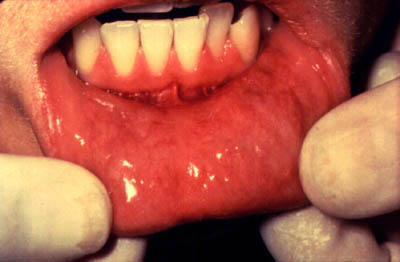
* Primary infection
o Most infections are caused by HSV-1 and are localized to the mouth and oropharynx. Only 10-30% of orolabial infections are symptomatic.
o The most common clinical presentation of first-episode, primary herpes simplex virus infection in children (usually aged 6 mo to 5 y) is acute herpetic gingivostomatitis.
o Clinical features include the following:
+ Abrupt onset of illness
+ Fever
+ Listlessness or irritability
+ Inability to eat and/or drink
+ Gingivitis (with markedly swollen, erythematous, and occasionally bleeding gums)
+ Increased drooling in infants due to pain on swallowing
+ Vesicular lesions on the tongue, buccal mucosa, and palate with extension, at times, to the lips and face (These may rupture and coalesce to form large, ulcerated areas.)
+ Tender submandibular or cervical adenopathy
o The lesions can be quite painful and symptoms may persist for 10-14 days. Primary herpes simplex virus infection of the oropharynx may be associated with viral shedding for as long as 23 days.
o Primary HSV-1 infection of the oropharynx in adolescents and adults usually manifests as pharyngotonsillitis rather than gingivostomatitis. Patients usually present with fever, malaise, odynophagia, and headache with vesiculoulcerative lesions on the tonsils.
o Primary HSV-2 infection can have a presentation similar to this after orogenital contact and it may occur concurrently with genital herpes simplex virus infection.
* Reactivation
o Reactivation of herpes simplex virus from the trigeminal ganglion is usually not associated with clinical findings. Reactivation of infection follows manipulation of the trigeminal nerve route or dental manipulation.
o Signs and symptoms associated with recurrences are usually mild. A prodrome of localized pain, tingling, burning, or itching is followed by eruption of vesicular lesions. The prodrome may occur 6-53 hours before the first vesicular lesions appear.
o The most common site of recurrent orolabial lesions is the outer edge of the vermilion border. On occasion, vesicles may be noted on other areas of the face or in the nares. The pattern of recurrent disease varies greatly from one person to the other. However, specific triggers may be fairly predictable for individual patients and the lesions tend to recur at the same site as the original lesions.
o HSV-1 orolabial infections recur at a rate of approximately 0.1 episode per month or 1.2 per year.
Genital infections
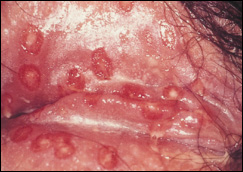
Primary infection occurs in the absence of preexisting antibodies to herpes simplex virus, either HSV-1 or HSV-2. First episode nonprimary infections occur in the absence of any previous signs or symptoms of genital herpes but in the presence of preexisting heterologous antibodies.
* Primary infection
o Primary, first-episode genital infections are characterized by severe constitutional symptoms, including fever, malaise, and mylagias. Itching and pain usually precede the development of symptoms by 1-2 days.
o Lesions evolve from vesicles to pustules to wet ulcers and heal by crusting. New lesions develop over 7-8 days. Lesions are distributed over labia majora, labia minora, mons pubis, vaginal mucosa, and cervix in women and over the shaft of the penis in men. Painful inguinal lymphadenopathy, dysuria, and vaginal discharge are frequent complaints. Complications in both sexes include paresthesias of the legs and perineum. Urinary retention, more common in women than in men, may be reported. Mean duration of viral shedding is 12 days.
o Preexisting antibodies to HSV-1 have an ameliorating effect on the severity of disease caused by HSV-2. Previous orofacial infection with HSV-1 generally protects a person against infection with HSV-1 but not HSV-2.
o Most primary genital herpes simplex virus infections are asymptomatic, and 70-80% of seropositive individuals have no history of symptomatic genital herpes. Periodic subclinical recurrences with viral shedding make them sources of infection.
o Nonprimary first episode infections have lower frequencies of systemic symptoms, fewer lesions and more rapid healing than in patients with primary infections, presumably due to preexisting heterologous antibodies.
* Reactivation
o Recurrences are more common with HSV-2 infections than with HSV-1 infections (5 vs 1 per y). Individuals with HSV-2 infection generally have high rates of recurrence in the first and second years followed by a substantial decrease in subsequent years (median, 2 per y). About 25% of individuals have at least one recurrence in 5 years.
o Most recurrences of genital herpes are asymptomatic. One percent of individuals with previous HSV-2 infection have viral shedding in the absence of clinical symptoms.
o Genital lesions are few and confined. Tender lymphadenopathy, dysuria, vaginal discharge, and systemic symptoms are less common. Factors implicated in recurrences include emotional stress and menses
Intrauterine and perinatal infections
* Congenital herpes simplex virus infection is a very rare entity and has been infrequently reported in the literature.31 Manifestations include skin lesions and scars, chorioretinitis, and microcephaly.
* Most neonatal herpes simplex virus infections result from exposure of the neonate to infected maternal genital secretions. The risk of the infection is largely influenced by the antibody status of the mother. About 50% of neonates exposed to maternal primary herpes simplex virus infection contract the virus as opposed to less than 5% of those exposed to recurrent herpes simplex virus disease.
* Neonates with herpes simplex virus infection manifest disease in 3 different ways as follows:
o Skin, eye, and mucous membrane (SEM) disease: Infection with herpes simplex virus limited to SEM historically accounts for about 20% of all neonatal herpes simplex virus infections. Infants with SEM infections generally present at age 10-12 days. Skin lesions tend to appear at the site of trauma. Many newborns with herpes simplex virus–related SEM disease do not present with symptoms of systemic illness. Outcome of SEM disease is excellent with prompt antiviral therapy; however, 75% of the cases progress to disseminated disease without treatment.
o Disseminated infection: Disseminated infection now accounts for approximately 25% of herpes simplex virus infections in newborns. The recognition and treatment of herpes simplex virus–related SEM disease early has resulted in lower rates of progression to disseminated disease than in years past. It usually presents during the first few days of life as severe bacterial infection. Clinical findings include jaundice, hepatomegaly, and respiratory dysfunction. Progression of infection is rapid in the absence of treatment.
o CNS infection: Nearly one third of infants with neonatal herpes simplex virus infection have encephalitis as the sole manifestation of disease. Patients usually present with symptoms and signs of illness at 2-3 weeks of age. Initial manifestations include lethargy, irritability, and focal seizures. Without treatment, most children with CNS disease die and survivors sustain severe neurologic impairment.
Herpes simplex virus CNS infection
* Herpes simplex virus encephalitis is the most common cause of severe sporadic CNS infection in the United States. One third of all cases of herpes simplex virus encephalitis are believed to occur in the pediatric population.
* Herpes simplex virus encephalitis may be a manifestation of primary or recurrent infection with the virus. The infection may have an insidious or an abrupt onset. Patients present with headache, altered consciousness, and focal neurological abnormalities with signs and symptoms consistent with temporal lobe involvement.
* Aseptic meningitis caused by herpes simplex virus can occur after primary genital HSV-2 infection. Patients with herpes simplex virus meningitis present with headache, fever, stiff neck, and photophobia. Symptoms usually begin 3-12 days after the onset of genital lesions. They reach maximum severity by 2-4 days into the illness, and gradually diminish over 2-3 days.
* Dysfunction of the autonomic nervous system and transverse myelitis has been associated with genital herpes simplex virus infection. Symptoms may include hyperesthesia or anesthesia of the lower back, perineum, or sacral region. Urinary retention and constipation are other associated symptoms.
Infection in immunocompromised hosts
* Severe herpes simplex virus infection in immunocompromised children is similar to that in adults. Infection is a frequent source of morbidity but is rarely fatal. The severity of disease is proportional to the deficiency of cellular immune responses.
* It is characterized by the presence of oral and genital lesions that progress slowly to involve contiguous mucosal surfaces and cause esophageal, tracheal or pulmonary involvement, leading to disseminated infection.
Other herpes simplex virus infections
* Patients with herpes simplex virus infection of the pulp or nail bed of the finger is referred to as herpetic whitlow.42 It presents with an acute onset of edema, erythema, and localized pain and tenderness in the finger. Associated fever and enlarged regional adenopathy are not uncommon.
* Herpes gladiatorum is a cutaneous infection seen among athletes participating in contact sports such as wrestling.43 It results in painful herpes simplex virus lesions, frequently with numerous cutaneous vesicles.
* Keratoconjunctivitis manifests with acute onset of pain, watery discharge, itching, blurred vision, lid swelling, and conjunctival injection Acute retinal necrosis can result in blindness.
* Mollaret meningitis, a recurrent aseptic meningitis is rarely associated with herpes simplex virus. Low-grade fever, headache, and myalgias may occur with these episodes. Approximately 50% of patients have transitory neurologic symptoms of meningeal irritation. The disease usually spontaneously remits over days.
* Herpes simplex virus is one of the most common precipitating factors for erythema multiforme (EM). Approximately 15% of patients with EM provide a history of recurrent herpes simplex virus infections before the characteristic skin lesions erupt.
Physical Signs
Neonatal infections
* Skin lesions in SEM disease appear as macules which progress rapidly to vesicles on an erythematous base in areas of trauma, such as sites of attachment of fetal scalp electrodes, bulb syringe trauma sites on palatal mucosa, and circumcisions.
* Herpes simplex virus CNS disease presents usually between age 2-3 weeks with lethargy and focal seizures . Skin lesions are present in about 50% of patients. Cerebrospinal fluid (CSF) examination reveals pleocytosis and modestly elevated protein. The electroencephalogram is diffusely abnormal.
* Disseminated herpes simplex virus disease in neonates usually mimics severe bacterial infection, often presenting within the first few days of life. Skin lesions are often absent at the onset of illness but 70% of the patients demonstrate skin lesions at some point during the illness. Clinical findings include vascular instability, jaundice, hepatomegaly, and pneumonitis. Death is caused by shock, liver failure, respiratory failure, or neurologic deterioration.
Orolabial herpes simplex virus infections
* Primary herpetic gingivostomatitis results in vesicles and ulcers involving the hard and soft palate, gingiva, tongue, and lips. These lesions are initially vesicular, but rupture fairly rapidly, leaving 1-3 mm, shallow, gray-white ulcers on erythematous bases. Fever and cervical and/or submandibular adenopathy are common.
* Patients with herpes simplex virus pharyngotonsillitis typically present with ulcers and exudates on the posterior pharynx and tonsillar area. Lesions may also be noted on the tongue, buccal mucosa, or gingiva. Fever may last 2-7 days. Cervical adenopathy is common.
* Recurrent orolabial herpetic infection is preceded by a prodrome of pain, burning, tingling, and itching. The prodrome is followed by the emergence of painful vesicles 24-48 hours later. The vesicles evolve into pustules and heal by crusting. Lesions typically appear on the vermillion border of the lip.
Genital infections
* Primary genital herpes appears as macules and papules, followed by vesicles, pustules, and ulcers. Fever and localized inguinal adenopathy are frequently noted. Lesions are typically observed on labia major, labia minora, and mons pubis in females and on the shaft of the penis in males.
* The painful and tender lesions are associated with dysuria and may involve the buttocks, perineum, and vagina. Urinary retention is observed in 10-15% of female patients.
* As many as 25% of women with genital herpes simplex virus have findings suggestive of meningitis.
* Recurrent herpes simplex virus infection causes ulcerating vesicular lesions or merely irritation of the vulva in women.
Herpes simplex virus CNS disease
* Biphasic age predilection is noted occurring in patients aged 5-30 years and older than 50 years.
* Patients typically have malaise, irritability, and nonspecific symptoms lasting 1-7 days followed by acute onset of fever and focal neurologic signs, with signs and symptoms suggestive of temporal lobe involvement.
* CSF analysis reveals pleocytosis with lymphocytic predominance and an increased number of RBCs.
* Electroencephalography typically reveals focal spike and slow-wave abnormalities early in the course of herpes simplex virus encephalitis. A characteristic finding of paroxysmal lateralizing epileptiform discharges (PLEDs) is observed.
* Edema with hemorrhagic necrosis is observed on MRI of the brain.
Herpes simplex virus in the immunocompromised patient
* Patients with primary immunodeficiencies, AIDS, malignancy, malnutrition, burns, and transplant recipients (eg, bone marrow, organs) receiving immunosuppressive therapy can have unusually severe herpes simplex virus infections.
* Severe orolabial infections may begin as typical herpes simplex virus lesions in or around the mouth. Over several days, the papules and vesicles can progress to bullae, frequently with hemorrhagic fluid. These bullae then may evolve into large, chronic, bloody lesions that coalesce and erode into the subcutaneous tissue or deeper tissues.
* Orolabial herpes simplex virus infection may involve contiguous mucosal surfaces to cause herpes simplex virus esophagitis, tracheitis, pneumonitis, or disseminated infection. Patients with esophagitis typically present with fever, retrosternal pain, and odynophagia and patients with pneumonitis present in respiratory failure.
Other herpes simplex virus infections
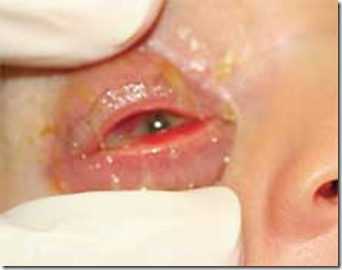
* Herpes simplex virus infection of the eye presents as blepharitis, follicular conjunctivitis, or keratoconjunctivitis. Signs include corneal or conjunctival injection, watery discharge, lid swelling, and preauricular adenopathy.
* Patients with Mollaret meningitis present with fever, nuchal rigidity, and transitory neurologic findings that accompany meningeal irritation.
